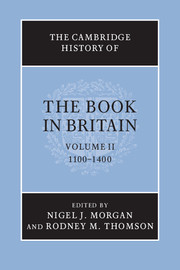Book contents
- Frontmatter
- Preface
- The roles of books
- Book production
- Readership, libraries, texts and contexts
- 9 Library catalogues and indexes
- 10 University and monastic texts
- 11 Law
- 12 Books for the liturgy and private prayer
- 13 Compilations for preaching and Lollard literature
- 14 Spiritual writings and religious instruction
- 15 Vernacular literature and its readership
- I The Anglo-Norman book
- II Middle English literary writings, 1150–1400
- III The Welsh book
- 16 History and history books
- 17 Archive books
- 18 Scientific and medical writings
- 19 Music
- 20 Illustration and ornament
- List of abbreviations
- Bibliography
- Photo credits
- General index
- Index of manuscripts
- Plates 1
- Plates 2
- References
III - The Welsh book
from 15 - Vernacular literature and its readership
Published online by Cambridge University Press: 28 November 2008
- Frontmatter
- Preface
- The roles of books
- Book production
- Readership, libraries, texts and contexts
- 9 Library catalogues and indexes
- 10 University and monastic texts
- 11 Law
- 12 Books for the liturgy and private prayer
- 13 Compilations for preaching and Lollard literature
- 14 Spiritual writings and religious instruction
- 15 Vernacular literature and its readership
- I The Anglo-Norman book
- II Middle English literary writings, 1150–1400
- III The Welsh book
- 16 History and history books
- 17 Archive books
- 18 Scientific and medical writings
- 19 Music
- 20 Illustration and ornament
- List of abbreviations
- Bibliography
- Photo credits
- General index
- Index of manuscripts
- Plates 1
- Plates 2
- References
Summary
Welsh literature in the year 1400 was in antiquity and diversity (not to broach questions of quality) comparable to that in English. But in contrast, this Welsh literature survives only in books written after about 1250; in books, however – some eighty manuscripts survive for the period 1250–1400 – which are as well produced as their English contemporaries. The point needs to be made in view of the rapid divergence in this respect after 1400, when Wales went into post-Glyndŵr depression while in England the commercial production of fine books in the vernacular became widespread.
At the fountainhead of Welsh poetry stand Aneirin and Taliesin. While questions have been raised, no convincing arguments have been put forward to gainsay the sixth-century origin of a core of the surviving work attributed to these two bards who are named (with others) in connection with sixth-century rulers in the Historia Brittonum. Of early written transmission of the poetry, all that can safely be said is that the texts contain corruptions which can only be explained as misreadings of Insular script: derivation from Insular exemplars could have been as late as the twelfth century.
Surviving written Welsh in books of the period 800–1100 is confined to marginalia, short added texts and glosses. But comparison with neighbouring Ireland and England makes it improbable that books in the vernacular were unknown in Wales. The case is probably one of non-survival, one which calls for explanation. Gerald of Wales refers to books in Welsh, once in reference to genealogy, once to prophetic poetry, but no twelfth-century example survives.
- Type
- Chapter
- Information
- The Cambridge History of the Book in Britain , pp. 390 - 396Publisher: Cambridge University PressPrint publication year: 2008



